Assessing the Combined Impact of Land Surface Temperature and Droughts to Heatwaves over Europe Between 2003 and 2023
Abstract
1. Introduction
2. Materials and Methods
2.1. Study Area
2.2. Data
2.3. Methodology
2.3.1. Calculation of Maximum Surface Temperature (LSTmax) Anomaly Indices
- Annual Maximum LST: For each pixel, the maximum LST values (LSTmax) were determined for each year using daily LST values.
- Climatological Statistics: The mean (LSTmax,mean) and standard deviation (LSTmax,std) of all annual LSTmax values were computed for each pixel.
- Standardized Anomaly: the standardized LSTmax anomaly was computed by subtracting the long-term (2003–2022) annual mean of LSTmax (LSTmax,mean) from the daily LSTmax values, and then dividing by the corresponding annual standard deviation (LSTmax,std):
2.3.2. Analysis of Heatwaves and Energy Fluxes at Specific Locations
2.3.3. Drought Detection
3. Results
3.1. Maximum Surface Temperature (LSTmax) Anomaly Indices
3.2. Analysis of Heatwaves and Energy Fluxes at Specific Locations
4. Discussion
4.1. Heat Wave and Drought Monitoring
4.2. Spatiotemporal Dynamics of Heatwaves and Droughts in Europe
4.3. Vegetation Controls on Surface Energy Fluxes Under Heat and Drought
4.4. Planning for Heat Resilience
4.5. Spatial Scale Effects and Datasets Uncertainty
4.6. Land Surface Emissivity Influence
5. Conclusions
Author Contributions
Funding
Data Availability Statement
Conflicts of Interest
References
- Dosio, A.; Mentaschi, L.; Fischer, E.M.; Wyser, K. Extreme Heat Waves under 1.5 °C and 2 °C Global Warming. Environ. Res. Lett. 2018, 13, 054006. [Google Scholar] [CrossRef]
- Coumou, D.; Rahmstorf, S. A Decade of Weather Extremes. Nat. Clim. Change 2012, 2, 491–496. [Google Scholar] [CrossRef]
- Van Loon, A.F.; Rangecroft, S.; Coxon, G.; Werner, M.; Wanders, N.; Di Baldassarre, G.; Tijdeman, E.; Bosman, M.; Gleeson, T.; Nauditt, A.; et al. Streamflow Droughts Aggravated by Human Activities despite Management. Environ. Res. Lett. 2022, 17, 044059. [Google Scholar] [CrossRef]
- Vicente-Serrano, S.M.; McVicar, T.R.; Miralles, D.G.; Yang, Y.; Tomas-Burguera, M. Unraveling the Influence of Atmospheric Evaporative Demand on Drought and Its Response to Climate Change. Wiley Interdiscip. Rev. Clim. Change 2020, 11, e632. [Google Scholar] [CrossRef]
- Grillakis, M.G. Increase in Severe and Extreme Soil Moisture Droughts for Europe under Climate Change. Sci. Total Environ. 2019, 660, 1245–1255. [Google Scholar] [CrossRef]
- García-León, D.; Casanueva, A.; Standardi, G.; Burgstall, A.; Flouris, A.D.; Nybo, L. Current and Projected Regional Economic Impacts of Heatwaves in Europe. Nat. Commun. 2021, 12, 5807. [Google Scholar] [CrossRef]
- Amengual, A.; Homar, V.; Romero, R.; Brooks, H.E.; Ramis, C.; Gordaliza, M.; Alonso, S. Projections of Heat Waves with High Impact on Human Health in Europe. Glob. Planet. Change 2014, 119, 71–84. [Google Scholar] [CrossRef]
- Zscheischler, J.; Martius, O.; Westra, S.; Bevacqua, E.; Raymond, C.; Horton, R.M.; van den Hurk, B.; AghaKouchak, A.; Jézéquel, A.; Mahecha, M.D.; et al. A Typology of Compound Weather and Climate Events. Nat. Rev. Earth Environ. 2020, 1, 333–347. [Google Scholar] [CrossRef]
- Barriopedro, D.; García-Herrera, R.; Ordóñez, C.; Miralles, D.G.; Salcedo-Sanz, S. Heat Waves: Physical Understanding and Scientific Challenges. Rev. Geophys. 2023, 61, e2022RG000780. [Google Scholar] [CrossRef]
- Perkins, S.E.; Alexander, L.V. On the Measurement of Heat Waves. J. Clim. 2013, 26, 4500–4517. [Google Scholar] [CrossRef]
- Engdaw, M.M.; Ballinger, A.P.; Hegerl, G.C.; Steiner, A.K. Changes in Temperature and Heat Waves over Africa Using Observational and Reanalysis Data Sets. Int. J. Climatol. 2022, 42, 1165–1180. [Google Scholar] [CrossRef]
- Hulley, G.; Ghent, D. Taking the Temperature of the Earth: Steps towards Integrated Understanding of Variability and Change; Elsevier: Amsterdam, The Netherlands, 2019. [Google Scholar]
- Li, Z.-L.; Tang, B.-H.; Wu, H.; Ren, H.; Yan, G.; Wan, Z.; Trigo, I.F.; Sobrino, J.A. Satellite-Derived Land Surface Temperature: Current Status and Perspectives. Remote Sens. Environ. 2013, 131, 14–37. [Google Scholar] [CrossRef]
- Philippopoulos, K.; Pantavou, K.; Cartalis, C.; Agathangelidis, I.; Mavrakou, T.; Polydoros, A.; Nikolopoulos, G. A Novel Artificial Neural Network Methodology to Produce High-Resolution Bioclimatic Maps Using Earth Observation Data: A Case Study for Cyprus. Sci. Total Environ. 2023, 893, 164734. [Google Scholar] [CrossRef]
- Reiners, P.; Sobrino, J.; Kuenzer, C. Satellite-Derived Land Surface Temperature Dynamics in the Context of Global Change—A Review. Remote Sens. 2023, 15, 1857. [Google Scholar] [CrossRef]
- Mildrexler, D.J.; Zhao, M.; Cohen, W.B.; Running, S.W.; Song, X.P.; Jones, M.O. Thermal Anomalies Detect Critical Global Land Surface Changes. J. Appl. Meteorol. Climatol. 2018, 57, 391–411. [Google Scholar] [CrossRef]
- Agathangelidis, I.; Cartalis, C.; Polydoros, A.; Mavrakou, T.; Philippopoulos, K. Can Satellite-Based Thermal Anomalies Be Indicative of Heatwaves? An Investigation for MODIS Land Surface Temperatures in the Mediterranean Region. Remote Sens. 2022, 14, 3139. [Google Scholar] [CrossRef]
- Martins, J.P.A.; Caetano, S.; Pereira, C.; Dutra, E.; Cardoso, R.M. A Satellite View of the Exceptionally Warm Summer of 2022 over Europe. Nat. Hazards Earth Syst. Sci. 2024, 24, 1501–1520. [Google Scholar] [CrossRef]
- Miralles, D.G.; Gentine, P.; Seneviratne, S.I.; Teuling, A.J. Land–Atmospheric Feedbacks during Droughts and Heatwaves: State of the Science and Current Challenges. Ann. N. Y. Acad. Sci. 2019, 1436, 19–35. [Google Scholar] [CrossRef]
- Benson, D.O.; Dirmeyer, P.A. Characterizing the Relationship between Temperature and Soil Moisture Extremes and Their Role in the Exacerbation of Heat Waves over the Contiguous United States. J. Clim. 2021, 34, 2175–2187. [Google Scholar] [CrossRef]
- Orth, R. When the Land Surface Shifts Gears. AGU Adv. 2021, 2, e2021AV000414. [Google Scholar] [CrossRef]
- Schumacher, D.L.; Keune, J.; Dirmeyer, P.; Miralles, D.G. Drought Self-Propagation in Drylands Due to Land–Atmosphere Feedbacks. Nat. Geosci. 2022, 15, 262–268. [Google Scholar] [CrossRef]
- Zargar, A.; Sadiq, R.; Naser, B.; Khan, F.I. A Review of Drought Indices. Environ. Rev. 2011, 19, 333–349. [Google Scholar] [CrossRef]
- Gebrechorkos, S.H.; Peng, J.; Dyer, E.; Miralles, D.G.; Vicente-Serrano, S.M.; Funk, C.; Beck, H.E.; Asfaw, D.T.; Singer, M.B.; Dadson, S.J. Global High-Resolution Drought Indices for 1981–2022. Earth Syst. Sci. Data 2023, 15, 5449–5466. [Google Scholar] [CrossRef]
- Afshar, M.H.; Bulut, B.; Duzenli, E.; Amjad, M.; Yilmaz, M.T. Global Spatiotemporal Consistency between Meteorological and Soil Moisture Drought Indices. Agric. For. Meteorol. 2022, 316, 108848. [Google Scholar] [CrossRef]
- Vicente-Serrano, S.M.; Beguería, S.; López-Moreno, J.I.; Angulo, M.; El Kenawy, A. A New Global 0.5 Gridded Dataset (1901–2006) of a Multiscalar Drought Index: Comparison with Current Drought Index Datasets Based on the Palmer Drought Severity Index. J. Hydrometeorol. 2010, 11, 1033–1043. [Google Scholar] [CrossRef]
- Ziese, M.; Schneider, U.; Meyer-Christoffer, A.; Schamm, K.; Vido, J.; Finger, P.; Bissolli, P.; Pietzsch, S.; Becker, A. The GPCC Drought Index–a New, Combined and Gridded Global Drought Index. Earth Syst. Sci. Data 2014, 6, 285–295. [Google Scholar] [CrossRef]
- Keune, J.; Di Giuseppe, F.; Barnard, C.; Damasio da Costa, E.; Wetterhall, F. ERA5–Drought: Global Drought Indices Based on ECMWF Reanalysis. Sci. Data 2025, 12, 616. [Google Scholar] [CrossRef]
- Hanel, M.; Rakovec, O.; Markonis, Y.; Máca, P.; Samaniego, L.; Kyselý, J.; Kumar, R. Revisiting the Recent European Droughts from a Long-Term Perspective. Sci. Rep. 2018, 8, 9499. [Google Scholar] [CrossRef]
- Kogan, F.N. Application of Vegetation Index and Brightness Temperature for Drought Detection. Adv. Space Res. 1995, 15, 91–100. [Google Scholar] [CrossRef]
- Wan, Z.; Wang, P.; Li, X. Using MODIS Land Surface Temperature and Normalized Difference Vegetation Index Products for Monitoring Drought in the Southern Great Plains, USA. Int. J. Remote Sens. 2004, 25, 61–72. [Google Scholar] [CrossRef]
- Gouveia, C.M.; Martins, J.P.A.; Russo, A.; Durão, R.; Trigo, I.F. Monitoring Heat Extremes across Central Europe Using Land Surface Temperature Data Records from SEVIRI/MSG. Remote Sens. 2022, 14, 3470. [Google Scholar] [CrossRef]
- Teuling, A.J.; Seneviratne, S.I.; Stöckli, R.; Reichstein, M.; Moors, E.; Ciais, P.; Luyssaert, S.; van den Hurk, B.; Ammann, C.; Bernhofer, C.; et al. Contrasting Response of European Forest and Grassland Energy Exchange to Heatwaves. Nat. Geosci. 2010, 3, 722–727. [Google Scholar] [CrossRef]
- Teuling, A.J.; Van Loon, A.F.; Seneviratne, S.I.; Lehner, I.; Aubinet, M.; Heinesch, B.; Bernhofer, C.; Grünwald, T.; Prasse, H.; Spank, U. Evapotranspiration Amplifies European Summer Drought. Geophys. Res. Lett. 2013, 40, 2071–2075. [Google Scholar] [CrossRef]
- Russo, S.; Sillmann, J.; Fischer, E.M. Top Ten European Heatwaves since 1950 and Their Occurrence in the Coming Decades. Environ. Res. Lett. 2015, 10, 124003. [Google Scholar] [CrossRef]
- Rousi, E.; Kornhuber, K.; Beobide-Arsuaga, G.; Luo, F.; Coumou, D. Accelerated Western European Heatwave Trends Linked to More-Persistent Double Jets over Eurasia. Nat. Commun. 2022, 13, 3851. [Google Scholar] [CrossRef]
- Dirmeyer, P.A.; Balsamo, G.; Blyth, E.M.; Morrison, R.; Cooper, H.M. Land-Atmosphere Interactions Exacerbated the Drought and Heatwave Over Northern Europe During Summer 2018. AGU Adv. 2021, 2, e2020AV000283. [Google Scholar] [CrossRef]
- Mohammed, S.; Arshad, S.; Alsilibe, F.; Moazzam, M.F.U.; Bashir, B.; Prodhan, F.A.; Alsalman, A.; Vad, A.; Ratonyi, T.; Harsányi, E. Utilizing Machine Learning and CMIP6 Projections for Short-Term Agricultural Drought Monitoring in Central Europe (1900–2100). J. Hydrol. 2024, 633, 130968. [Google Scholar] [CrossRef]
- Wan, Z.; Dozier, J. A Generalized Split-Window Algorithm for Retrieving Land-Surface Temperature from Space. IEEE Trans. Geosci. Remote Sens. 1996, 34, 892–905. [Google Scholar] [CrossRef]
- Snyder, W.C.; Wan, Z.; Zhang, Y.; Feng, Y.-Z. Classification-Based Emissivity for Land Surface Temperature Measurement from Space. Int. J. Remote Sens. 1998, 19, 2753–2774. [Google Scholar] [CrossRef]
- Gorelick, N.; Hancher, M.; Dixon, M.; Ilyushchenko, S.; Thau, D.; Moore, R. Google Earth Engine: Planetary-Scale Geospatial Analysis for Everyone. Remote Sens. Environ. 2017, 202, 18–27. [Google Scholar] [CrossRef]
- Beck, H.E.; Wood, E.F.; Pan, M.; Fisher, C.K.; Miralles, D.G.; van Dijk, A.I.J.M.; McVicar, T.R.; Adler, R.F. MSWEP V2 Global 3-Hourly 0.1° Precipitation: Methodology and Quantitative Assessment. Bull. Am. Meteorol. Soc. 2019, 100, 473–500. [Google Scholar] [CrossRef]
- Singer, M.B.; Asfaw, D.T.; Rosolem, R.; Cuthbert, M.O.; Miralles, D.G.; MacLeod, D.; Quichimbo, E.A.; Michaelides, K. Hourly Potential Evapotranspiration at 0.1° Resolution for the Global Land Surface from 1981-Present. Sci. Data 2021, 8, 224. [Google Scholar] [CrossRef] [PubMed]
- Martens, B.; Miralles, D.G.; Lievens, H.; Van Der Schalie, R.; De Jeu, R.A.; Fernández-Prieto, D.; Beck, H.E.; Dorigo, W.A.; Verhoest, N.E. GLEAM v3: Satellite-Based Land Evaporation and Root-Zone Soil Moisture. Geosci. Model Dev. 2017, 10, 1903–1925. [Google Scholar] [CrossRef]
- Lipson, M.; Grimmond, S.; Best, M.; Chow, W.T.L.; Christen, A.; Chrysoulakis, N.; Coutts, A.; Crawford, B.; Earl, S.; Evans, J.; et al. Harmonized Gap-Filled Datasets from 20 Urban Flux Tower Sites. Earth Syst. Sci. Data 2022, 14, 5157–5178. [Google Scholar] [CrossRef]
- Perkins-Kirkpatrick, S.E.; Lewis, S.C. Increasing Trends in Regional Heatwaves. Nat. Commun. 2020, 11, 3357. [Google Scholar] [CrossRef]
- Wang, C.; Li, Z.; Chen, Y.; Ouyang, L.; Zhao, H.; Zhu, J.; Wang, J.; Zhao, Y. Characteristic Changes in Compound Drought and Heatwave Events under Climate Change. Atmos. Res. 2024, 305, 107440. [Google Scholar] [CrossRef]
- Hao, Z.; Hao, F.; Xia, Y.; Feng, S.; Sun, C.; Zhang, X.; Fu, Y.; Hao, Y.; Zhang, Y.; Meng, Y. Compound Droughts and Hot Extremes: Characteristics, Drivers, Changes, and Impacts. Earth-Sci. Rev. 2022, 235, 104241. [Google Scholar] [CrossRef]
- Fischer, E.M.; Seneviratne, S.I.; Vidale, P.L.; Lüthi, D.; Schär, C. Soil Moisture–Atmosphere Interactions during the 2003 European Summer Heat Wave. J. Clim. 2007, 20, 5081–5099. [Google Scholar] [CrossRef]
- Dole, R.; Hoerling, M.; Perlwitz, J.; Eischeid, J.; Pegion, P.; Zhang, T.; Quan, X.-W.; Xu, T.; Murray, D. Was There a Basis for Anticipating the 2010 Russian Heat Wave? Geophys. Res. Lett. 2011, 38, L06702. [Google Scholar] [CrossRef]
- Tripathy, K.P.; Mishra, A.K. How Unusual Is the 2022 European Compound Drought and Heatwave Event? Geophys. Res. Lett. 2023, 50, e2023GL105453. [Google Scholar] [CrossRef]
- Lenton, T.M.; Abrams, J.F.; Bartsch, A.; Bathiany, S.; Boulton, C.A.; Buxton, J.E.; Conversi, A.; Cunliffe, A.M.; Hebden, S.; Lavergne, T.; et al. Remotely Sensing Potential Climate Change Tipping Points across Scales. Nat. Commun. 2024, 15, 343. [Google Scholar] [CrossRef] [PubMed]
- Founda, D.; Giannakopoulos, C. The Exceptionally Hot Summer of 2007 in Athens, Greece—A Typical Summer in the Future Climate? Glob. Planet. Change 2009, 67, 227–236. [Google Scholar] [CrossRef]
- Bennett, A.C.; McDowell, N.G.; Allen, C.D.; Anderson-Teixeira, K.J. Larger Trees Suffer Most during Drought in Forests Worldwide. Nat. Plants 2015, 1, 15139. [Google Scholar] [CrossRef]
- Miralles, D.G.; Teuling, A.J.; van Heerwaarden, C.C.; Vilà-Guerau de Arellano, J. Mega-Heatwave Temperatures Due to Combined Soil Desiccation and Atmospheric Heat Accumulation. Nat. Geosci. 2014, 7, 345–349. [Google Scholar] [CrossRef]
- Guerreiro, S.B.; Dawson, R.J.; Kilsby, C.; Lewis, E.; Ford, A. Future Heat-Waves, Droughts and Floods in 571 European Cities. Environ. Res. Lett. 2018, 13, 034009. [Google Scholar] [CrossRef]
- Agathangelidis, I.; Blougouras, G.; Cartalis, C.; Polydoros, A.; Tzanis, C.G.; Philippopoulos, K. Global Climatology of the Daytime Surface Cooling of Urban Parks Using Satellite Observations. Geophys. Res. Lett. 2025, 52, e2024GL112887. [Google Scholar] [CrossRef]
- Stewart, I.D.; Oke, T.R. Local Climate Zones for Urban Temperature Studies. Bull. Amer. Meteor. Soc. 2012, 93, 1879–1900. [Google Scholar] [CrossRef]
- He, B.-J.; Fu, X.; Zhao, Z.; Chen, P.; Sharifi, A.; Li, H. Capability of LCZ Scheme to Differentiate Urban Thermal Environments in Five Megacities of China: Implications for Integrating LCZ System Into Heat-Resilient Planning and Design. IEEE J. Sel. Top. Appl. Earth Obs. Remote Sens. 2024, 17, 18800–18817. [Google Scholar] [CrossRef]
- Giannaros, C.; Agathangelidis, I.; Galanaki, E.; Cartalis, C.; Kotroni, V.; Lagouvardos, K.; Giannaros, T.M.; Matzarakis, A. Hourly Values of an Advanced Human-Biometeorological Index for Diverse Populations from 1991 to 2020 in Greece. Sci. Data 2024, 11, 76. [Google Scholar] [CrossRef]
- Yang, Y.; Anderson, M.C.; Gao, F.; Wood, J.D.; Gu, L.; Hain, C. Studying Drought-Induced Forest Mortality Using High Spatiotemporal Resolution Evapotranspiration Data from Thermal Satellite Imaging. Remote Sens. Environ. 2021, 265, 112640. [Google Scholar] [CrossRef]
- Liu, H.; Xin, X.; Su, Z.; Zeng, Y.; Lian, T.; Li, L.; Yu, S.; Zhang, H. Intercomparison and Evaluation of Ten Global ET Products at Site and Basin Scales. J. Hydrol. 2023, 617, 128887. [Google Scholar] [CrossRef]
- van Dijke, A.J.H.; Orth, R.; Teuling, A.J.; Herold, M.; Schlerf, M.; Migliavacca, M.; Machwitz, M.; van Hateren, T.C.; Yu, X.; Mallick, K. Comparing Forest and Grassland Drought Responses Inferred from Eddy Covariance and Earth Observation. Agric. For. Meteorol. 2023, 341, 109635. [Google Scholar] [CrossRef]
- Li, Z.-L.; Wu, H.; Wang, N.; Qiu, S.; Sobrino, J.A.; Wan, Z.; Tang, B.-H.; Yan, G. Land Surface Emissivity Retrieval from Satellite Data. Int. J. Remote Sens. 2013, 34, 3084–3127. [Google Scholar] [CrossRef]


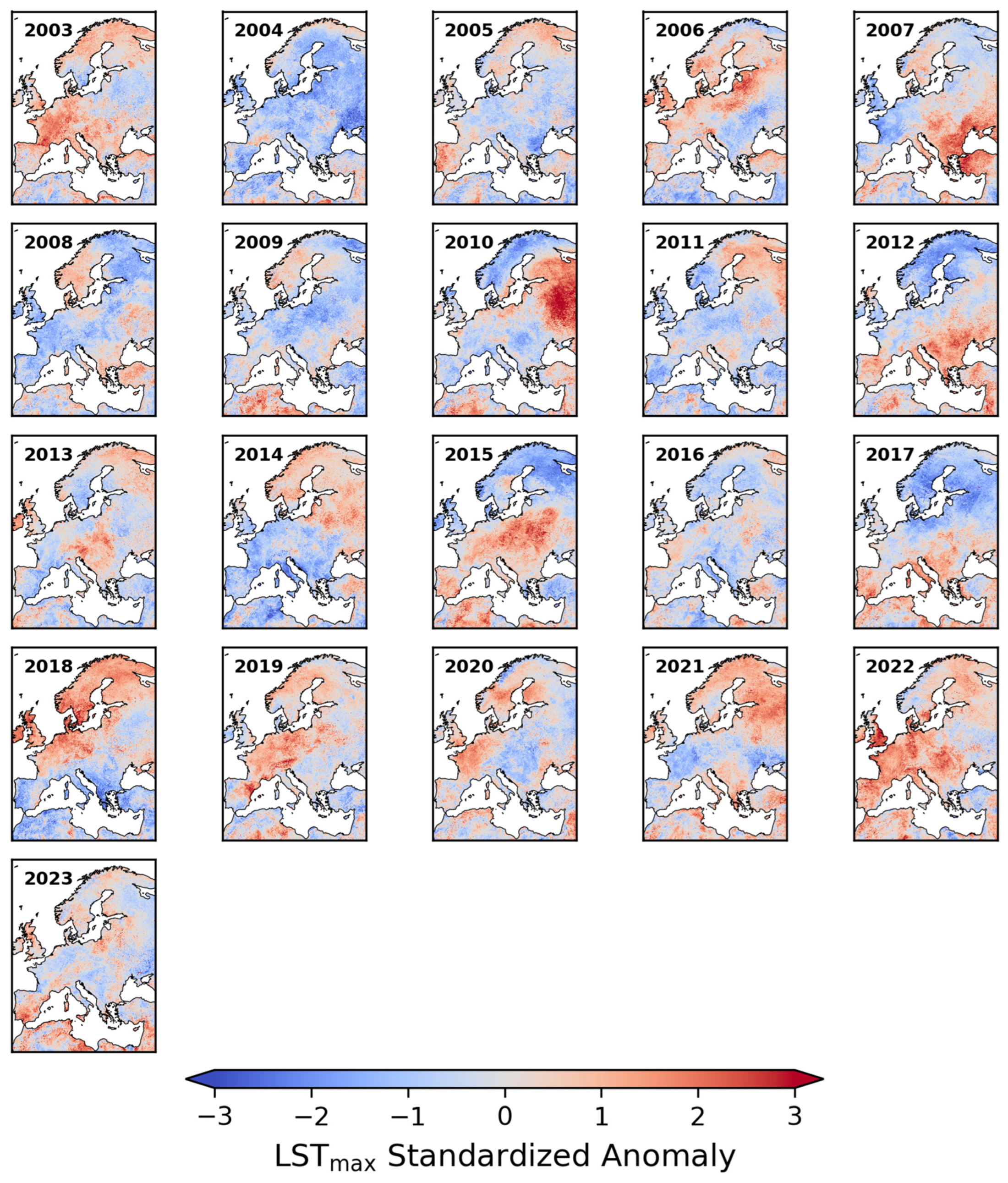
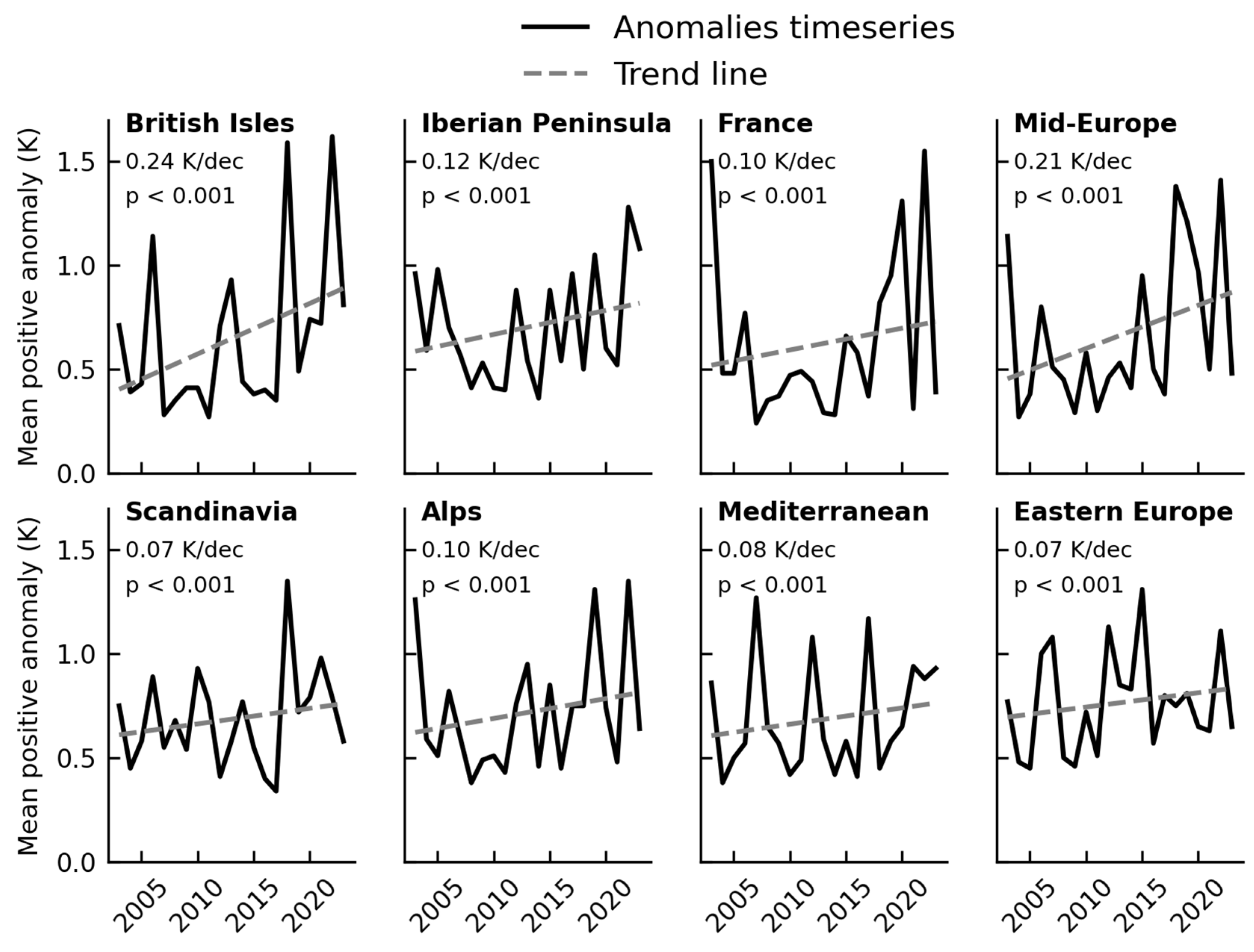
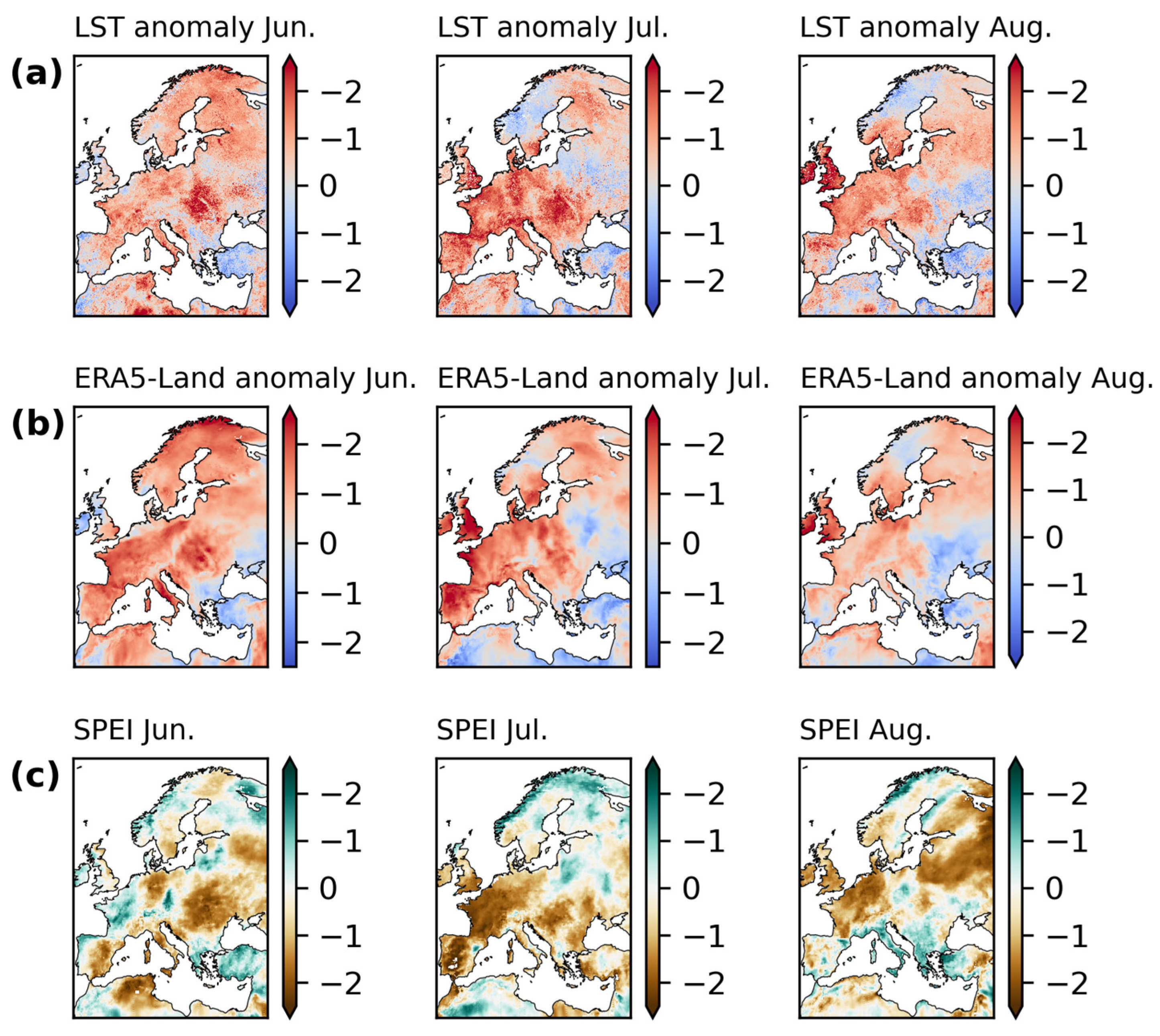

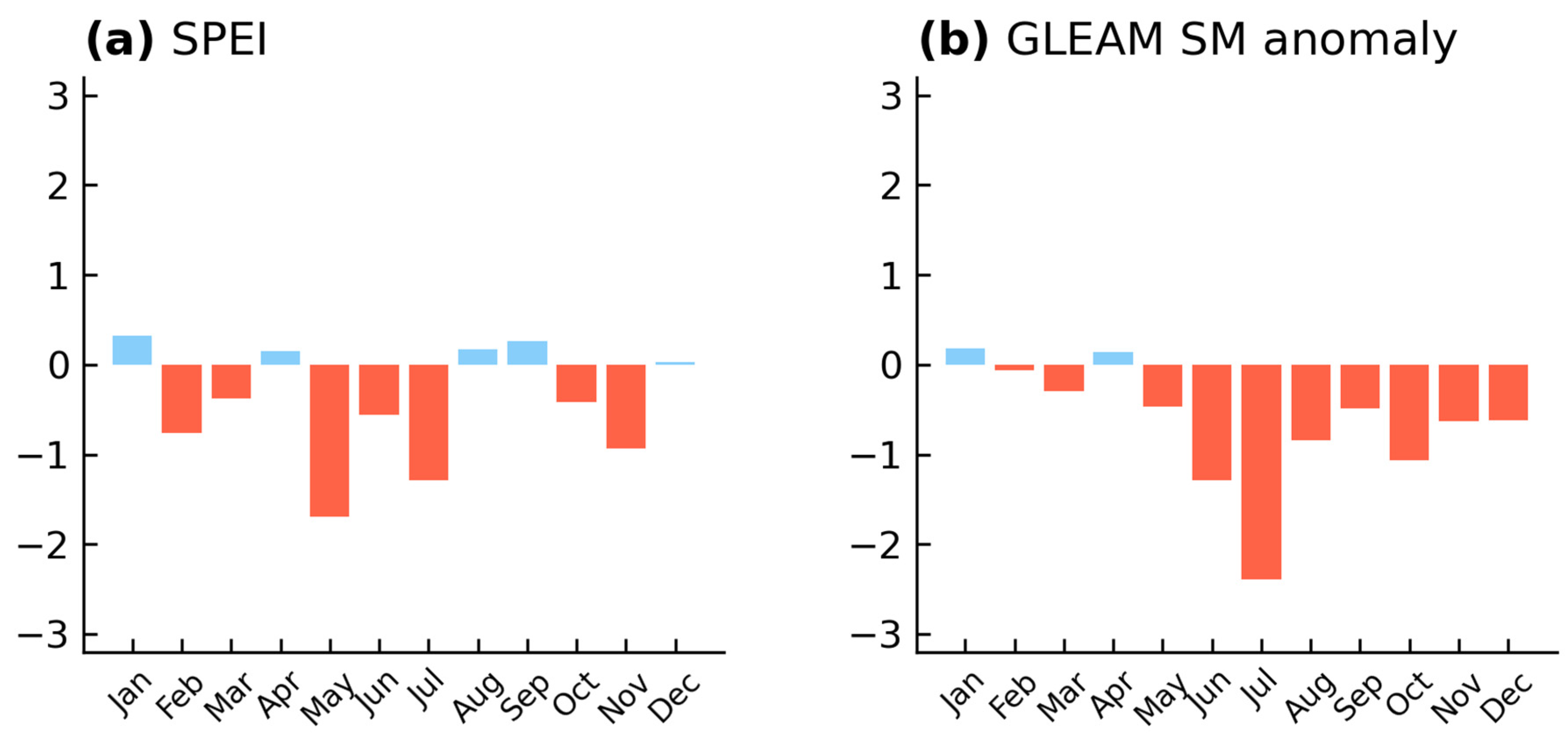
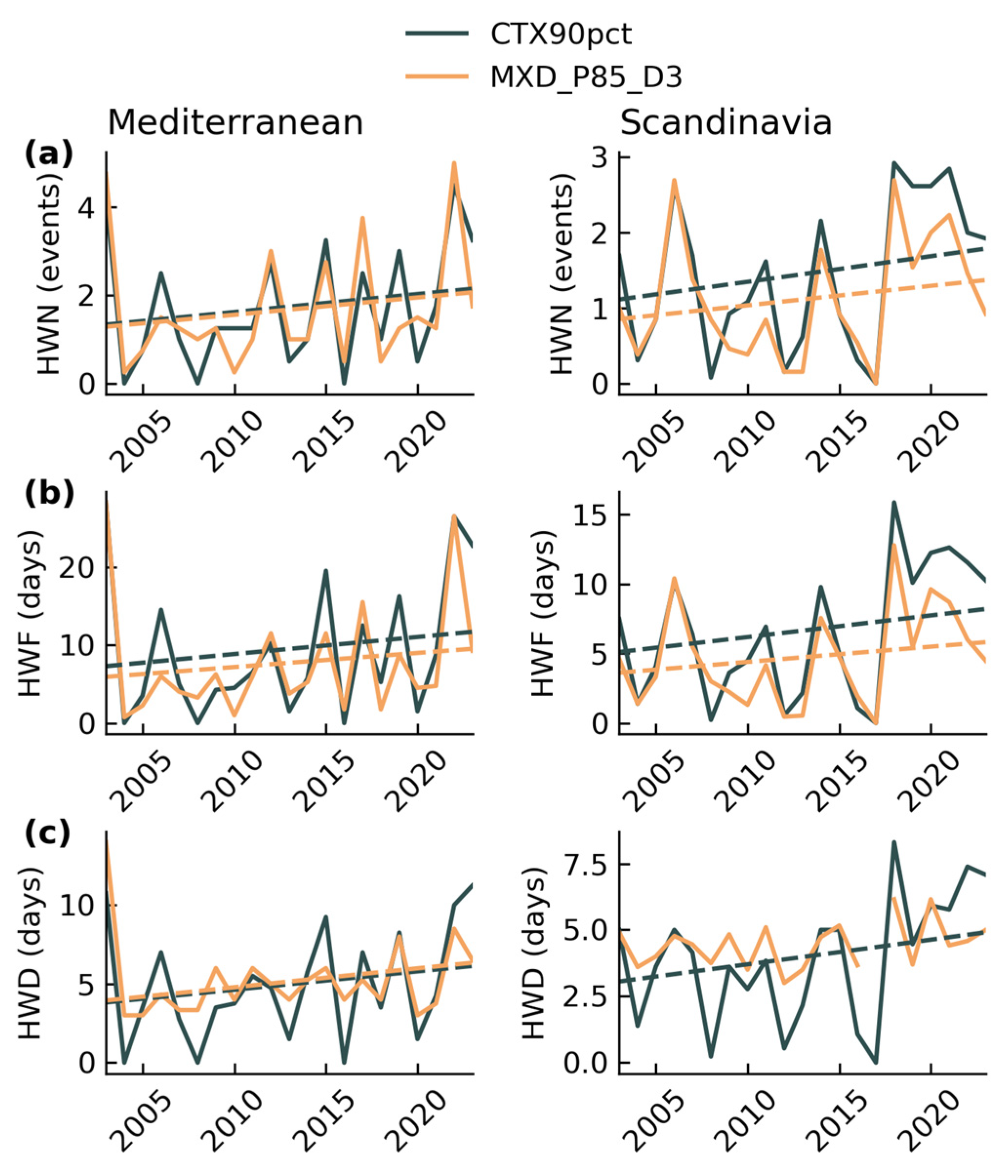
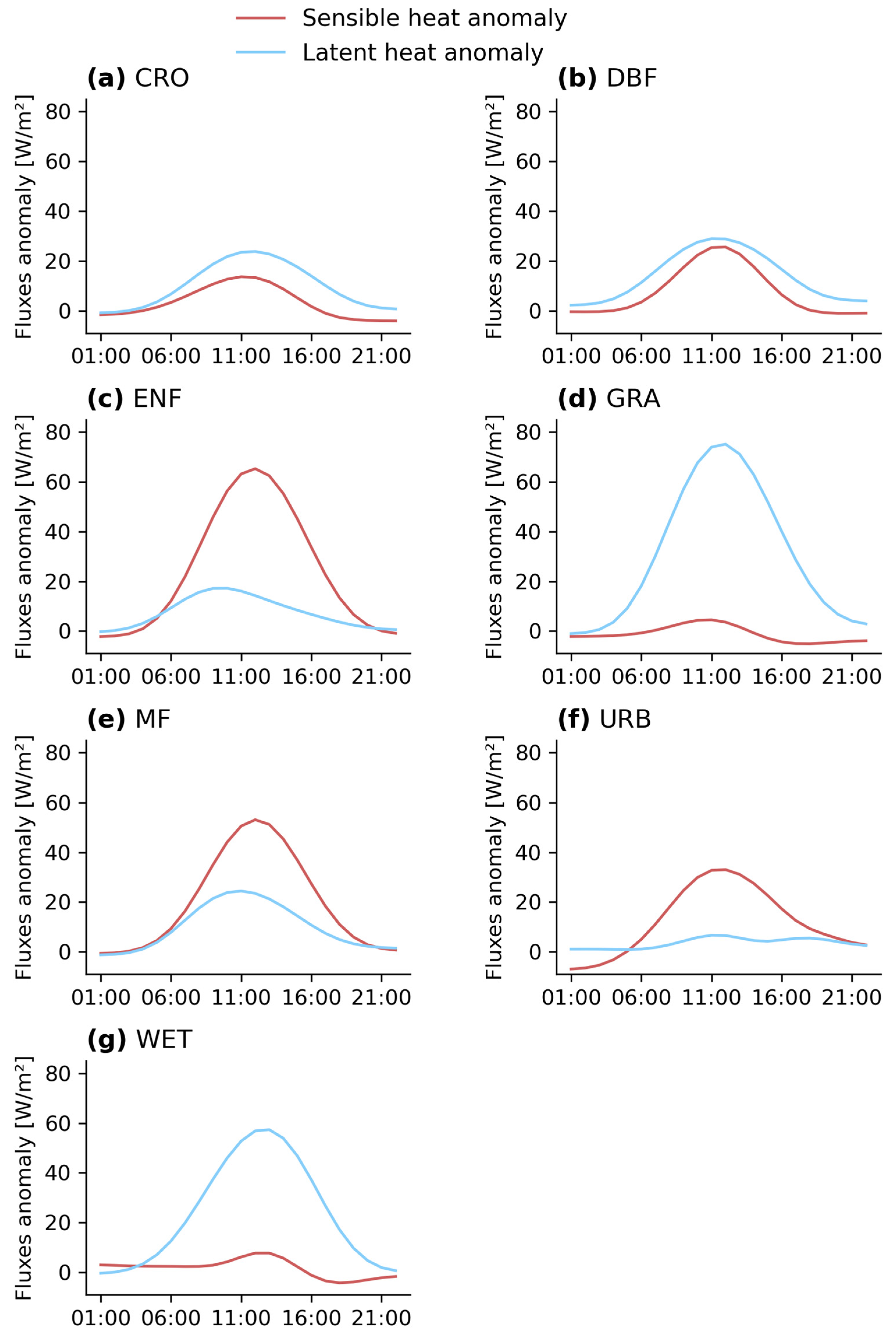


| Short Name | Full Name and Details | Variable | Spatial Resolution | Temporal Resolution | Type |
|---|---|---|---|---|---|
| MYD11A1 | Aqua MODIS LST/Emissivity Daily Version 6.1 | LST | ~1 km | Daily | Satellite |
| MYD14A1 | Aqua MODIS Thermal Anomalies and Fire Daily Level 3 Version 6.1 | Fire mask | ~1 km | Daily | Satellite |
| MYD11A2 | Aqua MODIS LST/Emissivity 8-day composites Version 6.1 | LST | ~1 km | 8-day composite | Satellite |
| MYD14A2 | Aqua MODIS Thermal Anomalies and Fire 8-day composites Level 3 Version 6.1 | Fire mask | ~1 km | 8-day composite | Satellite |
| ERA5-Land | ERA5-Land post-processed daily statistics from 1950 to present | Tmax | ~9 km | Daily | Reanalysis |
| SPEI-HR | Hydro-JULES: Global high-resolution drought datasets from 1981–2022 | SPEI | ~5 km | Monthly | Reanalysis/Satellite |
| GLEAM SM | GLEAM v3.7b: global dataset of different components of terrestrial evaporation spanning the 20-year period 2003–2022. | Soil moisture | ~25 km | Daily | Satellite/Model |
| ICOS | Warm Winter 2020 ecosystem eddy covariance flux product for 73 stations in FLUXNET-Archive format—release 2022-1 | QH, QE | Point-based | 30 min | Flux tower |
| Urban-PLUMBER | Harmonized, gap-filled dataset from 20 urban flux tower sites for the Urban-PLUMBER (Protocol for the Analysis of Land Surface Models Benchmarking Evaluation) project | QH, QE | Point-based | 30 min | Flux tower |
| Landcover | Number of Sites |
|---|---|
| Croplands (CRO) | 33 |
| Closed Shrublands (CSH) | 3 |
| Deciduous Broadleaf Forests (DBF) | 26 |
| Evergreen Broadleaf Forests (EBF) | 2 |
| Evergreen Needleleaf Forests (ENF) | 62 |
| Grasslands (GRA) | 26 |
| Mixed Forests (MF) | 15 |
| Open Shrublands (OSH) | 9 |
| Savannas (SAV) | 9 |
| Permanent Wetlands (WET) | 16 |
| Urban (URB) | 8 |
| Woody Savannas (WSA) | 3 |
| Year | AL | BI | EA | FR | IP | MD | ME | SC |
|---|---|---|---|---|---|---|---|---|
| 2003 | 5.5 | 0.0 | 0.0 | 0.0 | 7.5 | 0.0 | 3.4 | 0.4 |
| 2004 | 0.0 | 0.0 | 0.0 | 0.8 | 0.0 | 0.0 | 0.0 | 0.0 |
| 2005 | 0.0 | 0.0 | 0.0 | 0.0 | 3.6 | 0.0 | 0.1 | 0.0 |
| 2006 | 2.4 | 0.0 | 2.5 | 0.8 | 0.1 | 0.0 | 2.9 | 2.4 |
| 2007 | 0.8 | 0.0 | 0.0 | 0.0 | 0.0 | 4.0 | 0.0 | 0.0 |
| 2008 | 0.0 | 0.0 | 0.0 | 0.0 | 0.0 | 0.0 | 0.0 | 0.0 |
| 2009 | 0.2 | 0.0 | 0.0 | 0.0 | 2.6 | 0.0 | 0.0 | 0.0 |
| 2010 | 0.3 | 0.0 | 0.0 | 0.0 | 0.0 | 0.0 | 0.1 | 0.6 |
| 2011 | 2.1 | 0.0 | 0.0 | 0.0 | 0.0 | 0.0 | 0.0 | 0.0 |
| 2012 | 0.5 | 0.0 | 0.0 | 0.8 | 0.6 | 0.0 | 0.0 | 0.0 |
| 2013 | 0.4 | 0.0 | 1.8 | 0.0 | 0.0 | 0.0 | 0.1 | 0.0 |
| 2014 | 0.0 | 0.0 | 2.5 | 0.0 | 0.0 | 0.0 | 1.2 | 0.0 |
| 2015 | 4.1 | 0.0 | 5.8 | 0.5 | 3.2 | 0.0 | 1.4 | 2.6 |
| 2016 | 0.6 | 0.0 | 0.0 | 3.0 | 0.4 | 0.0 | 0.0 | 0.0 |
| 2017 | 0.0 | 0.0 | 0.8 | 0.0 | 1.4 | 0.0 | 0.3 | 0.0 |
| 2018 | 0.4 | 5.0 | 5.5 | 0.0 | 0.4 | 0.0 | 4.8 | 5.9 |
| 2019 | 2.9 | 0.0 | 1.8 | 4.0 | 0.0 | 0.0 | 2.3 | 0.0 |
| 2020 | 0.2 | 0.0 | 0.0 | 0.0 | 0.0 | 0.0 | 0.0 | 0.0 |
| 2021 | 0.3 | 0.0 | 0.0 | 0.0 | 0.4 | 0.0 | 0.0 | 1.4 |
| 2022 | 1.9 | 6.0 | 0.0 | 7.8 | 15.8 | 9.0 | 2.5 | 0.0 |
| Date | Sensible Heat (W/m2) | Latent Heat (W/m2) |
|---|---|---|
| 30 July 2018 | 13 | 95.1 |
| 31 July 2018 | −4 | 51.2 |
| 1 August 2018 | −6.1 | 11.9 |
| 3 August 2018 | 63.6 | 50.8 |
| 4 August 2018 | 94.4 | −68.6 |
| 5 August 2018 | 119.9 | −43.2 |
| 6 August 2018 | 81.2 | −17.7 |
| 7 August 2018 | 81.7 | −34.9 |
Disclaimer/Publisher’s Note: The statements, opinions and data contained in all publications are solely those of the individual author(s) and contributor(s) and not of MDPI and/or the editor(s). MDPI and/or the editor(s) disclaim responsibility for any injury to people or property resulting from any ideas, methods, instructions or products referred to in the content. |
© 2025 by the authors. Licensee MDPI, Basel, Switzerland. This article is an open access article distributed under the terms and conditions of the Creative Commons Attribution (CC BY) license (https://creativecommons.org/licenses/by/4.0/).
Share and Cite
Karinou, F.; Agathangelidis, I.; Cartalis, C. Assessing the Combined Impact of Land Surface Temperature and Droughts to Heatwaves over Europe Between 2003 and 2023. Remote Sens. 2025, 17, 1655. https://doi.org/10.3390/rs17091655
Karinou F, Agathangelidis I, Cartalis C. Assessing the Combined Impact of Land Surface Temperature and Droughts to Heatwaves over Europe Between 2003 and 2023. Remote Sensing. 2025; 17(9):1655. https://doi.org/10.3390/rs17091655
Chicago/Turabian StyleKarinou, Foteini, Ilias Agathangelidis, and Constantinos Cartalis. 2025. "Assessing the Combined Impact of Land Surface Temperature and Droughts to Heatwaves over Europe Between 2003 and 2023" Remote Sensing 17, no. 9: 1655. https://doi.org/10.3390/rs17091655
APA StyleKarinou, F., Agathangelidis, I., & Cartalis, C. (2025). Assessing the Combined Impact of Land Surface Temperature and Droughts to Heatwaves over Europe Between 2003 and 2023. Remote Sensing, 17(9), 1655. https://doi.org/10.3390/rs17091655








